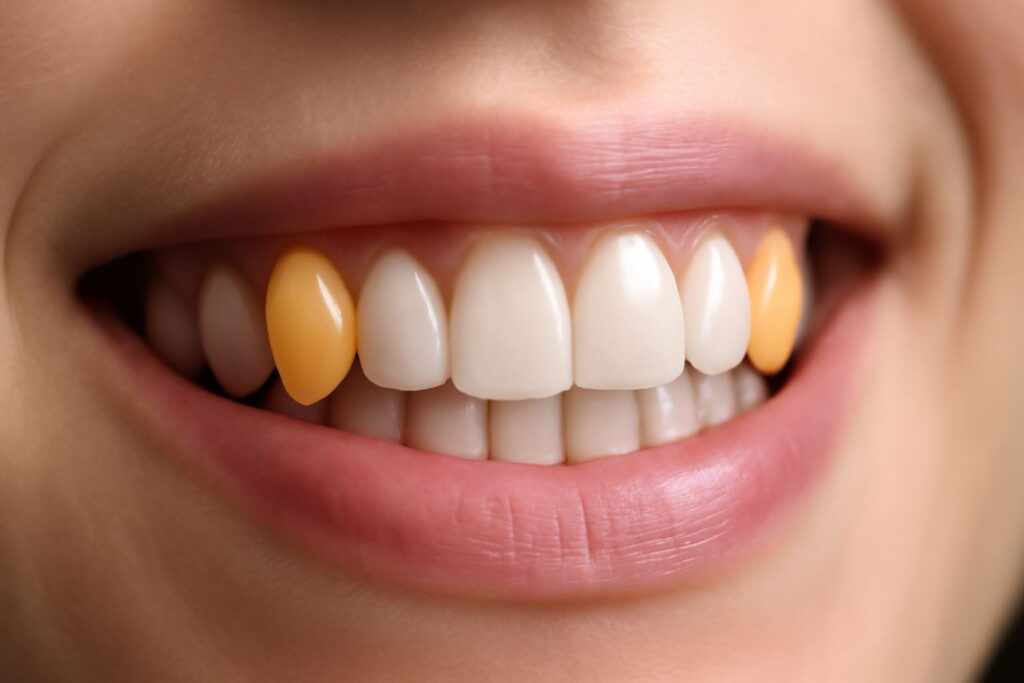When you smile in the mirror, you probably notice the four pointed teeth sitting at the corners of your mouth. These are called cuspid teeth, though most people know them as canine teeth or even eye teeth. Small but mighty, they play an important role in how we eat, speak, and even how our smile looks.
Cuspid teeth aren’t just there for show. They help us tear into food, guide our bite so our jaws move smoothly, and support the shape of our lips and face. If they’re missing, misaligned, or impacted, it can affect much more than appearance—it can change the way we chew, speak, and even our overall dental health.
In this guide, we’ll explore everything you need to know about cuspid teeth: their anatomy, how they function, the problems that can sometimes occur, and the best ways to keep them healthy for life.
1. What Are Cuspid Teeth?
Cuspid teeth are the pointed, fang-like teeth that sit at the corners of your smile. Most people recognize them right away because of their sharp tip and slightly longer shape compared to other front teeth. Dentists often call them canine teeth, and in everyday conversation, they’re also known as eye teeth because of their position just beneath the eyes.
The name “cuspid” comes from the Latin word cuspis, which means point. This makes sense, as these teeth are designed with a single sharp cusp that helps us tear into food.
In terms of location, you’ll find cuspids in a very important spot: between the incisors (the flat front teeth you use for cutting food) and the premolars (the broader teeth used for grinding). Because of this strategic placement, cuspids act like anchors, keeping your bite balanced and guiding your jaw when you chew or speak.
2. Anatomy & Types of Cuspid Teeth
Cuspid teeth may look small, but they are some of the strongest and most important teeth in your mouth. Each cuspid has a single sharp cusp (pointed tip) and a long, conical root. In fact, they have the longest roots of any front teeth, which makes them very stable and excellent anchors for your bite.
There are two main types of cuspids:
- Maxillary cuspids (upper cuspids):
Found in the upper jaw, these teeth are usually a little larger and more pointed. They typically erupt around 11 to 12 years of age, just after the incisors and before the premolars. - Mandibular cuspids (lower cuspids):
Located in the lower jaw, these are slightly narrower compared to the upper cuspids. They usually come in earlier, around 9 to 10 years of age.
In children, there are deciduous cuspids (baby canines), which usually erupt between 16 and 22 months of age. Later, as the child grows, these are naturally replaced by permanent cuspids, which stay with us for life once they erupt.
Because of their strength and strategic placement, cuspids play a vital role in guiding other teeth into proper position as the jaw develops.
3. Functions of Cuspid Teeth
Cuspid teeth aren’t just there to make your smile look sharp—they serve several important purposes in everyday life.
- Tearing and gripping food:
With their pointed cusp, these teeth are built to tear into tougher foods like meat, vegetables, or bread. They act like little spears that help break food down before it reaches the flatter chewing teeth. - Guiding jaw movement:
Dentists often talk about “canine guidance.” This means cuspids help guide your jaw when it moves side to side, preventing too much pressure on other teeth and protecting them from wear. - Maintaining alignment:
Because of their long roots and strong position in the dental arch, cuspids are often called the “cornerstones of the mouth.” They keep nearby teeth in place and help ensure your bite stays balanced. - Supporting facial structure:
Cuspids also give support to the lips and cheeks. Without them, the mid-face could look less full, which can affect the shape of your smile and overall facial balance. - Assisting in speech:
Certain sounds, like “s” and “f,” rely on the placement of teeth. Cuspids help guide the tongue and lips during speech, ensuring clarity in pronunciation.
In short, cuspid teeth are multitaskers—they make eating easier, keep your bite healthy, support your facial shape, and even help you speak clearly.
4. Cusps & Variations
To really understand cuspid teeth, it helps to know what a cusp is. A cusp is the pointed tip or raised surface on a tooth that helps with cutting or grinding food.
- Cuspids vs. other teeth:
Cuspids have one sharp cusp, while premolars and molars have multiple cusps that make them better suited for grinding. This makes cuspids the only anterior teeth (front teeth) with a cusp, since incisors are flat and designed for cutting. - Sharp or high cuspid teeth:
Sometimes cuspids appear extra pointy or even sit slightly higher in the gum line. This can happen due to genetics, tooth eruption patterns, or misalignment. While sharp cuspids can give a dramatic look, they can also cause bite issues or wear on nearby teeth if they’re too prominent. - Talon cusp teeth:
In rare cases, a tooth may develop an extra cusp. This is called a talon cusp, which often appears on anterior teeth (like incisors or cuspids). While unusual, it can affect bite, cleaning, or even speech, and may require dental adjustment. - Teeth with extra cusps:
Though rare, some people develop additional cusps on different teeth. These variations can create dental challenges, such as crowding, uneven wear, or difficulty keeping the tooth clean. Dentists usually evaluate these cases individually to decide if treatment is needed.
Understanding these variations helps explain why not all cuspids look exactly the same. Some are sharper, some sit higher, and in rare cases, extra cusps may develop—each situation affecting oral health in different ways.
5. Common Problems with Cuspid Teeth
Even though cuspid teeth are some of the strongest in the mouth, they’re not immune to dental issues. Here are the most common problems people face with cuspids and how dentists usually manage them:
Impacted Cuspids
An impacted cuspid is a tooth that doesn’t erupt properly and remains trapped beneath the gum or bone. This happens most often with upper cuspids (maxillary) because they are the last front teeth to come in, usually around ages 11–13.
-
Causes:
- Not enough space in the dental arch.
- Crowding from other teeth.
- Misalignment or delayed eruption.
-
Complications:
Impacted cuspids can lead to crowding, orthodontic problems, cysts, infection, and even pain or swelling. If untreated, they may also damage the roots of nearby teeth.
-
Treatment:
- Orthodontic braces can create space and gently guide the tooth into place.
- Oral surgery may be needed to expose the cuspid so it can erupt naturally or be pulled into position with orthodontics.
- If the tooth cannot be saved, extraction followed by a dental implant or bridge may be recommended.
Gum Recession Around Cuspids
Cuspids often bear heavy biting forces, which can make them prone to gingival (gum) recession over time. This is when gum tissue pulls back, exposing more of the tooth’s surface.
-
Causes:
- Aggressive brushing with a hard toothbrush.
- Orthodontic stress or misaligned bite.
- Periodontal (gum) disease.
-
Solutions:
- Switch to gentle brushing with a soft-bristled toothbrush.
- Scaling and cleaning to remove plaque and tartar.
- Soft-tissue grafts to restore gum coverage.
- Orthodontic correction if misalignment is causing excessive pressure.
Cosmetic Concerns
Some people feel self-conscious about their cuspid teeth because they may look too sharp, pointy, or prominent. While this is usually not a medical issue, it can affect confidence.
- Treatment options include:
- Dental recontouring (reshaping the tooth slightly).
- Bonding (adding tooth-colored material for a softer look).
- Veneers or crowns for a more permanent cosmetic solution.
6. Interesting Facts About Cuspid Teeth
Cuspid teeth may seem ordinary, but they actually have some fascinating qualities that set them apart from the rest of your smile:
- Why they’re called “eye teeth”:
Cuspids sit just beneath the eyes in the upper jaw, which is why people often refer to them as eye teeth. - Longest roots among front teeth:
These teeth have the deepest and strongest roots of any front teeth, making them excellent anchors in the dental arch. This strength helps keep your bite stable. - Evolutionary role:
In animals like dogs, cats, and primates, cuspids (canines) are much larger and sharper. They’re used for hunting, defense, and tearing into meat. While human cuspids are smaller, they still carry this evolutionary design for gripping and tearing food. - Cultural and esthetic significance:
In some cultures, sharp cuspids have been seen as a sign of strength, vitality, or even beauty. In modern fashion trends, some people even request cosmetic reshaping to make their cuspids appear more prominent or “fang-like.”
These fun facts remind us that cuspid teeth are not just functional—they carry history, culture, and personality within every smile.
7. Caring for Cuspid Teeth
Like the rest of your teeth, cuspids need proper care to stay strong and healthy throughout life. Because they handle heavy biting forces and have such a visible role in your smile, looking after them is especially important.
- Brush daily with a gentle technique:
Use a soft-bristled toothbrush and avoid scrubbing too hard. Over-brushing can lead to gum recession, which often starts around cuspids. - Don’t forget flossing:
Floss or use interdental cleaners to remove food and plaque between the cuspids and neighboring teeth. This helps prevent cavities and gum disease. - Regular dental checkups:
Dentists monitor cuspids for proper eruption, alignment, and gum health. Early detection of crowding or gum issues can save you from bigger treatments later. - Orthodontic monitoring for kids and teens:
Since cuspids usually erupt between ages 9 and 13, this is a critical period. Orthodontists often check to make sure there’s enough space for them to come in naturally. - Cosmetic comfort tip:
For patients who feel their cuspids are too sharp or prominent, cosmetic contouring (gently reshaping the tooth) not only improves the look but also makes cleaning easier and more comfortable.
A little daily care combined with professional guidance goes a long way in protecting these “cornerstone teeth” for life.
8. Summary Table of Key Facts
| Aspect | Details |
| Anatomy | Pointed tooth with a single cusp; longest root among front teeth. |
| Location | Four total – two in the upper jaw, two in the lower jaw; between incisors and premolars. |
| Eruption Age | Lower cuspids: 9–10 years. Upper cuspids: 11–12 years. Baby cuspids: 16–22 months. |
| Functions | Tear and grip food, guide jaw movement, maintain bite alignment, support lips and face, assist in speech. |
| Common Issues | Impacted cuspids, gum recession, cosmetic concerns (sharp or high cuspids). |
| Care Tips | Gentle brushing, daily flossing, regular checkups, orthodontic monitoring in kids, cosmetic contouring if needed. |
Conclusion
Cuspid teeth may be small in number, but their importance is undeniable. From tearing food and guiding your bite to shaping your smile and supporting facial balance, they play a vital role in both function and aesthetics.
Of course, issues like impacted cuspids, gum recession, or sharp pointy teeth can sometimes cause trouble. The good news is that with today’s dental treatments—whether orthodontic guidance, gum care, or cosmetic contouring—these problems can be managed effectively.
With consistent daily care and regular dental checkups, your cuspids can stay strong and healthy for life. Think of them as the “cornerstones” of your smile—when protected, they’ll continue to support you in eating, speaking, and smiling with confidence.



